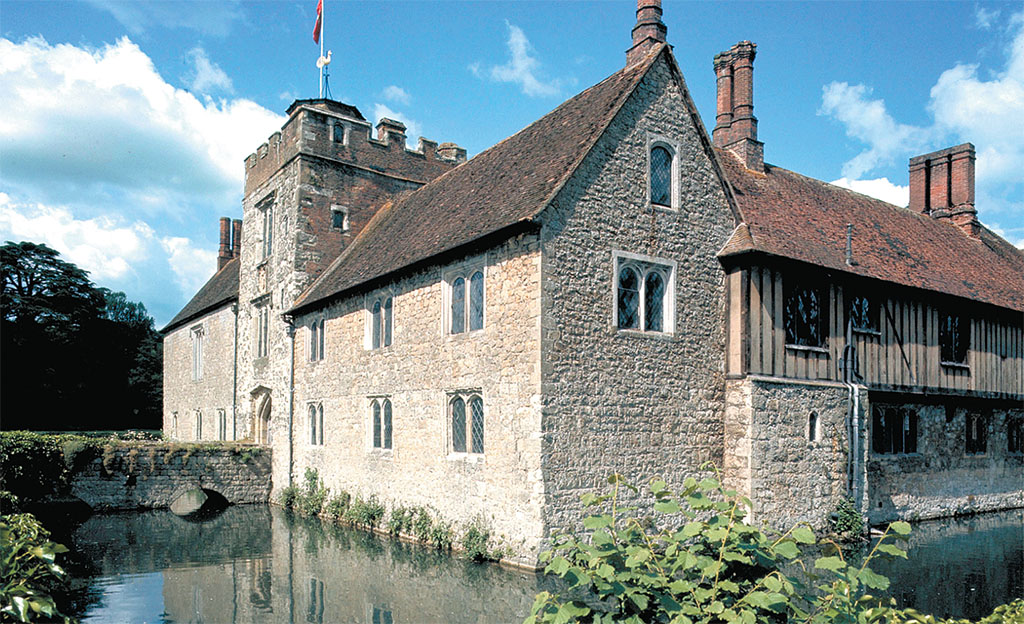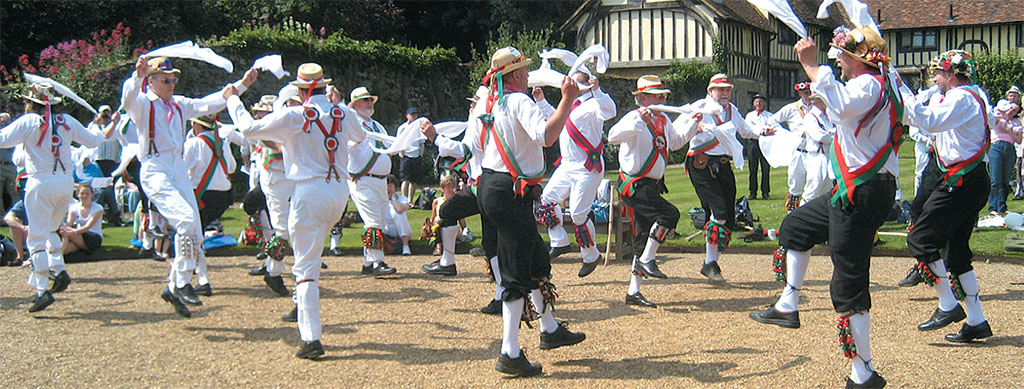
CDATA[NEAR THE LITTLE VILLAGE of Ivy Hatch, in Kent, lies one of the National Trust’s hidden gems, the quaint 14th-century moated manor house called Ightham Mote. As a visitor to this lovely property back in the early 1990s, I can still recall that moment of gratified surprise upon first seeing the manor’s exquisite timber-framed exterior and unique setting. This past summer, some 17 years later, I found myself back at Ightham Mote, not as a visitor, but as one of the thousands of volunteers who contribute time to a National Trust property.
[caption id="LendingaHandatIghthamMote_img1" align="aligncenter" width="1024"]

WWW.BRITAINONVIEW.COM
Planning this incredible working holiday last winter meant searching the National Trust’s Web site for volunteer opportunities. Many of the options sounded fascinating, but my first choice was to aid in some way at the site of a historic building.
The Trust recommended e-mailing specific sites of personal interest, and fortuitously, Linda Dillon, visitor services manager at Ightham Mote, smoothed the way for me to become the first American to volunteer at that particular property.
Securing the volunteer position was only the beginning, however. Next came the task of obtaining a five-week sabbatical from my job as a librarian in Highlands Ranch, Colo. Through the winter months, I surfed the Internet for the best flight deals, arranged a car rental and relied upon the Heart of Kent Web site to locate accommodation at Strawberry Cottage, a 10-minute drive from Ightham Mote through the back lanes of Kent. Set to volunteer four days a week meant I would have valuable sightseeing time as well, so I also acquired a Britrail pass for day trips to places such as York, Cambridge and Canterbury.
Arriving in London a few days ahead allowed me tourist time in the capital before picking up a Vauxhall Astra and wending my way from the busy suburbs of London out to the Garden of England. Strawberry Cottage proved to be the perfect accommodation for one person, set at the foot of lush strawberry fields.
In the beginning, “the American lady” was something of a curiosity, but I was eagerly welcomed to the volunteer family. There are more than 200 volunteers at Ightham Mote; most of them room stewards—a position I eagerly embraced. While many are retirees who volunteer for a day or two a week, others work regular jobs and come in on the occasional Sunday. The average length of time served as a volunteer is about eight years, according to Ann Davis, volunteer services assistant, but a few have been at the house since it came to the National Trust in 1985. In fact, the oldest volunteer is 91 years of age and still going strong!
The position of room steward is essential to the visitor’s experience at Ightham Mote. The steward’s job entails not only ensuring the security of the objects within a given room, but also making the visitors feel welcome and sharing the history and stories associated with each unique room. Having the opportunity to steward in each part of this amazing house, from the 14th-century Great Hall (my favorite) to the New Chapel, with its unusual Tudor painted ceiling, to the Drawing Room, with its Baroque fireplace and 18th-century hand-painted Chinese wallpaper, was a treat in itself.
Every day brought a new spate of visitors, most quite eager to learn about the history of the house, others intrigued by my lack of a British accent. By odd coincidence, the last private owner of Ightham Mote was an American, Charles Henry Robinson, from Portland, Maine. He willed the house to the Trust upon his death in 1985, and his ashes are buried in the Crypt. I was asked a dozen times a day if I was related to this fellow Anglophile.
[caption id="LendingaHandatIghthamMote_img2" align="aligncenter" width="1012"]

PATTY MATHISEN
Anyone considering this type of volunteer position should be prepared to “meet and greet,” stand for long periods of time and, most important, learn the history of the house inside and out. But for any avid history buff, there’s nothing better than driving to work via leafy one-lane roads.
Living near a small village and having self-catered accommodation also means participating in daily life. Simple acts, such as shopping at the closest Tesco or using the public library, give a local flavor to this unconventional vacation. Taking evening walks, reading or relaxing in front of a favorite BBC show add to the enjoyment.
After 50 hours of volunteer time, the National Trust, as a form of thank you, issues a card enabling the user to gain free entry into any of its properties, as well as a discount in its many shops and restaurants. My days off thus meant traveling about and seeing as many Trust properties as possible, as well as purchasing gifts from its shops for those back home.
While most of my time was spent stewarding, I also had a very enjoyable morning in the company of Joy Debney, a 20-year volunteer who oversees the archives at Ightham Mote. Debney is passionate about storing and researching photos and articles about the house. She shared some of the 19th-century photos, as well as old newspaper articles. Debney also handles any questions about the house requiring research, which often come from the general public. When asked what the most unusual question has been, she quickly answered, “Did my ancestor drown in the moat?” (The answer is no, there have been no documented drownings.)
[caption id="LendingaHandatIghthamMote_img3" align="aligncenter" width="1024"]

PATTY MATHISEN
One entertaining Sunday morning brought the Hartley Morris Men to perform. The colorful dancing troupe kept hands clapping and feet tapping. After the dancing, tradition dictates that the thirsty dancers gather in the courtyard around a keg of ale, drinking and singing old English melodies.
Most National Trust properties offer special days such as this one, and Ightham Mote also had a Hearing Dog 25th Anniversary celebration and a very popular Father’s Day event during the month of June. One can never predict what will bring out the crowds, but perhaps it was the combination of the model railroad demonstration, croquet on the lawn and beer tasting that brought out the huge numbers on Father’s Day. It was probably my most challenging day as a steward, with a sampling of crowd control matters.
It was a very sad day when I stewarded the last afternoon of my holiday. Bernadette Gillow, property manager of Ightham Mote, had organized a touching sendoff. Upon closing for the day, staff and volunteers gathered together for wine and nibbles. All asked if I would be back next year, which was flattering indeed. If only four-week vacations were a common occurrence.
I took my last photo in the courtyard, fittingly of Bernadette and her lovely greyhound, Toby, posing in front of the 19th-century dog kennel in the courtyard (it’s the only Grade I–listed dog kennel in the country). While the National Trust does acknowledge its volunteers, the greatest appreciation comes from the thank yous that one receives from the many visitors.
I quite miss everyone at Ightham Mote, who made this American so welcome, and will do my best to honor their request to return as soon as possible.





Comments